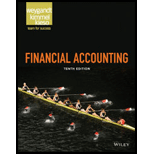
(a)
Inventory:
Inventory refers to the raw materials, work-in progress, and the finished goods products that are held by the business to sell or make it ready for sale, in the future date. The business must take into account its total inventory value. There are three prime methods of
- 1. First-in-first out method (FIFO)
- 2. Last-in-first out method (LIFO)
- 3. Average-cost method
To identify: The cost flow assumption used by the Company LV to value its inventory.
(b)
Inventory:
Inventory refers to the raw materials, work-in progress, and the finished goods products that are held by the business to sell or make it ready for sale, in the future date. The business must take into account its total inventory value. There are three prime methods of inventory valuation, they are:
- 1. First-in-first out method (FIFO)
- 2. Last-in-first out method (LIFO)
- 3. Average-cost method
To identify: The amount of goods purchased for retail, and finished products reported by the Company LV at December 31, 2015.
Want to see the full answer?
Check out a sample textbook solution
Chapter 6 Solutions
Financial Accounting
- PLEASE HELP. I HAVE PROVIDED THE DROPDOWN OPTIONSarrow_forwardThe difference between the balance in a company's cash account and its bank statement is documented in the __________ of the bank statement.arrow_forwardLarge corporations should report revenues on their income statements when the __________. Cash Is Received Revenues Are Earnedarrow_forward
- PLEASE HELP WITH THIS PROBLEMarrow_forwardThe KLM Medical Clinic has two auxiliary departments: the Building Maintenance Department and the Energy Production Department as well as three main production departments: the Department of Paediatrics, the Department of Internal Medicine and the Department of Surgery. The CLM allocates the cost of the building maintenance department based on the area occupied by the departments in square meters and the cost of the energy department based on the days of hospitalization of patients. No distinction is made between variable and fixed cost elements. The budgeted operating figures for the previous year were as follows: Auxiliary sections Main production departments Building maintenance Energy production Pediatrics Department of Internal Medicine Surgical Estimated cost before allocation 18.000,00 8.000,00 80.000,00 50.000,00 90.000,00 Area (in sq.m) 1.000,00 4.000,00 6.000,00 18.000,00 12.000,00 Patient Hospitalization…arrow_forwardwhat is financial accounting? explain its parts and all things.arrow_forward
- Manufacturing products. Parrow_forward4. ABG produces and sells a single product at the price of 20 euros. During its first year of operation (20X7), the company had no initial stocks. The production cost of a product unit is as follows: Variable production cost of 8 euros per unit. Fixed production cost 9,600 euros. Also, the company has fixed sales expenses of 5,400 euros. In the first year of operation, the company had budgeted that it would produce and sell 3,200 units of product. In fact, during the period production and sales amounted to 3,200 units of product. Requested: To calculate the operating result of the company for the first year of its operation using absorption and marginal costing. Calculate the operating result of the company for the first year of its operation using absorption and marginal costing, assuming that sales for the period amounted to 2,700 units and 500 units remained as final inventory. What is the value of the final inventory of stocks with both costing techniques in this case?arrow_forwardHello experts solve this qnarrow_forward

 AccountingAccountingISBN:9781337272094Author:WARREN, Carl S., Reeve, James M., Duchac, Jonathan E.Publisher:Cengage Learning,
AccountingAccountingISBN:9781337272094Author:WARREN, Carl S., Reeve, James M., Duchac, Jonathan E.Publisher:Cengage Learning, Accounting Information SystemsAccountingISBN:9781337619202Author:Hall, James A.Publisher:Cengage Learning,
Accounting Information SystemsAccountingISBN:9781337619202Author:Hall, James A.Publisher:Cengage Learning, Horngren's Cost Accounting: A Managerial Emphasis...AccountingISBN:9780134475585Author:Srikant M. Datar, Madhav V. RajanPublisher:PEARSON
Horngren's Cost Accounting: A Managerial Emphasis...AccountingISBN:9780134475585Author:Srikant M. Datar, Madhav V. RajanPublisher:PEARSON Intermediate AccountingAccountingISBN:9781259722660Author:J. David Spiceland, Mark W. Nelson, Wayne M ThomasPublisher:McGraw-Hill Education
Intermediate AccountingAccountingISBN:9781259722660Author:J. David Spiceland, Mark W. Nelson, Wayne M ThomasPublisher:McGraw-Hill Education Financial and Managerial AccountingAccountingISBN:9781259726705Author:John J Wild, Ken W. Shaw, Barbara Chiappetta Fundamental Accounting PrinciplesPublisher:McGraw-Hill Education
Financial and Managerial AccountingAccountingISBN:9781259726705Author:John J Wild, Ken W. Shaw, Barbara Chiappetta Fundamental Accounting PrinciplesPublisher:McGraw-Hill Education





